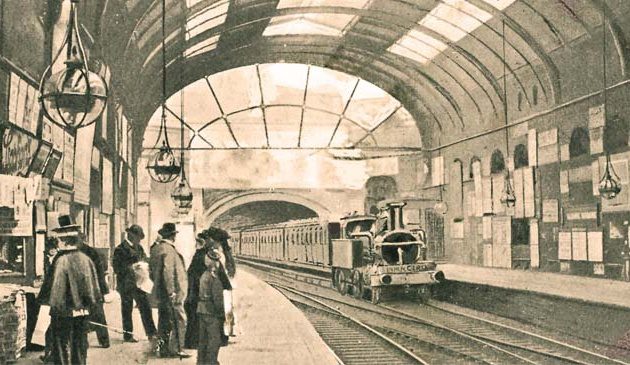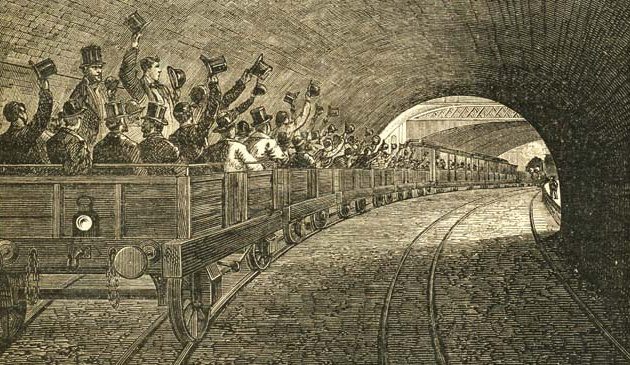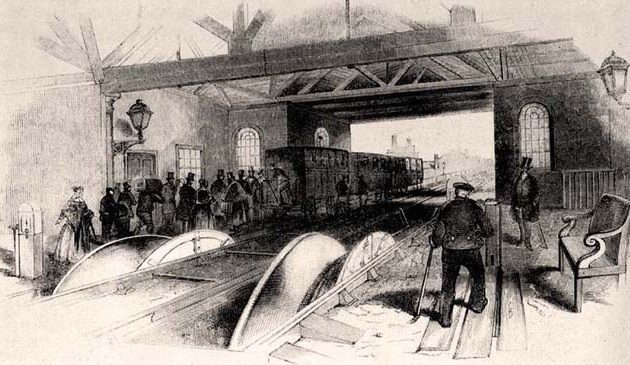London’s earliest long-distance railway

The entrance to the engine shed of the London & Birmingham Railway at Camden in 1838. This coloured lithograph was one of 50 made by the London artist John Cooke Bourne. He is best known for his pictures of the construction of the London & Birmingham and Great Western Railways, which were published in four volumes in 1838 and 1839. His interest in the railways was sparked when construction of the L&BR was taking place near his home.
The creation of the London & Birmingham Railway was the greatest work of civil engineering yet undertaken in Britain until that time. In the year prior to the commencement of construction Stephenson appointed a team of assistants with responsibility for certain sections of the line. John Cass Birkinshaw, son of the inventor of iron rails, Charles Fox, who was later knighted for his contribution to the creation of the Crystal Palace for the Great Exhibition, and George Watson Buck were the assistants for the London section. Stephenson set up an office for the whole project at the vacant Eyre Arms Hotel, which stood opposite where St. John’s Wood tube station is now located. There 40 draughtsmen worked day and night shifts to meet the demands of the company directors.
The directors instructed Stephenson to proceed with the London end of the line at the earliest possible time. The Chairman’s report of September 1833 stated:
This portion they would recommend to be executed with all the expedition which may be found consistent with the stability of the work, and other considerations, from a conviction that the novelty and convenience of a railway contiguous to the Metropolis cannot fail to excite a general interest, and consequently to prove an early and productive source of revenue to the Company.
Locomotives of the time could only manage a certain gradient, yet the chosen route had to traverse numerous hills, valleys, and waterways. Thus, many cuttings, embankments, viaducts and tunnels had to be made along the route. One of the most difficult sections was at the London end where the line had to rise out of the Thames Valley while also passing several natural obstacles. The contract for navigating the 21-mile section north from Camden, known as the ‘Brent contract’, was awarded to Messrs. Jackson & Sheddon.
A curved tunnel of 320 yards at Kensal Green under the Edgware Road was constructed by the cut-and-cover method, perhaps the world’s first tunnel to be created in that way. But there was much subsidence on a long embankment across the Brent Valley and gravel and chalk was continually added to reach the required height. Worse still, the 1,120-yard long Primrose Hill tunnel, bored through London clay, proved too problematic, leading to the bankruptcy of Jackson & Sheddon. The L&BR took over the work under the direct management of John Birkinshaw, with the final cost more than twice the original contract price. The completed tunnel was finished off with magnificent entrances in an Italianate style, a condition demanded by the Eton College estate, which was planning to develop the area with housing.
In the summer of 1837 12,000 workmen were employed in the work of construction. Expenditure was far in excess of what was estimated, in part because costs for labour and materials rose rapidly during construction due to other new railway projects competing for the same resources.
The company purchased 33 acres of land on the northern side of the Regent’s Canal at Camden for the terminus. Any further towards London would have involved passing across the estate of Lord Southampton, which would have jeopardised the passage of the Bill in the House of Lords. The nobleman subsequently realized that the value of his land would greatly increase if a railway passed through it, so he dropped any opposition.
London was at that time quickly expanding. Aristocratic landowners were taking advantage, leasing their land for new housing developments, including the Duke of Bedford who owned the Euston area. Gardens, known as Euston Square, were laid out either side of the New Road and in about 1817 luxury housing erected around it. The street named Euston Grove was laid out north from there in about 1820.
In August 1834, once the objections by Lord Southampton had fallen away, Stephenson proposed Euston, 1½ miles closer to London than Camden, as a more suitable site for the terminus. The company therefore purchased seven acres of pastureland from the Duke of Bedford. A new Act passed in July 1835, stating that what became known as ‘the Extension’ would be
…commencing in a Field on the West Side of the High Road leading from London to Hampstead, being the Site of the Depot or Station intended to be made for the Use of the said Railway, in the Parish of Saint Pancras in the County of Middlesex, and thence passing across the Regent’s Canal between the First and Second Bridges Westward of the Lock at Camden Town into and through the said Parish of Saint Pancras, and terminating in a vacant Piece of Ground in a Place called Euston Grove, on the North Side of Drummond Street near Euston Square in the same Parish, and which said Extension of Railway will pass through or into the Parish of Saint Pancras in the said County of Middlesex.
Euston was to be for passengers only, as laid down in the Act:
…it shall not be lawful for the said Company to receive at their intended Station in Euston Grove, for the Purpose of Transport, or to deliver out therefrom, any Merchandise, Cattle, or Goods of any Description, save and except Passengers Luggage and small Parcels.
Charles Fox was given responsibility for managing the creation of the Extension, and William & Lewis Cubitt were awarded the contract for construction. A thousand workers were employed.


